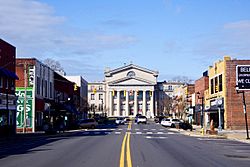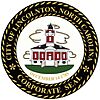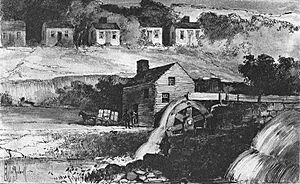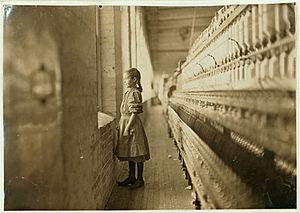Lincolnton, North Carolina facts for kids
Quick facts for kids
Lincolnton, North Carolina
|
|||
|---|---|---|---|

View along Main Street (NC 27)
|
|||
|
|||
| Motto(s):
"Near the City. Near the Mountains. Near Perfect."
|
|||

Location of Lincolnton, North Carolina
|
|||
| Country | United States | ||
| State | North Carolina | ||
| County | Lincoln | ||
| Named for | Benjamin Lincoln | ||
| Area | |||
| • Total | 8.75 sq mi (22.66 km2) | ||
| • Land | 8.68 sq mi (22.47 km2) | ||
| • Water | 0.07 sq mi (0.19 km2) | ||
| Elevation | 883 ft (269 m) | ||
| Population
(2020)
|
|||
| • Total | 11,091 | ||
| • Density | 1,278.50/sq mi (493.65/km2) | ||
| Time zone | UTC-5 (Eastern (EST)) | ||
| • Summer (DST) | UTC-4 (EDT) | ||
| ZIP code |
28092-28093
|
||
| Area code(s) | 704 | ||
| FIPS code | 37-38320 | ||
| GNIS feature ID | 2404933 | ||
Lincolnton is a city located in Lincoln County, North Carolina, in the United States. It's part of the larger Charlotte metropolitan area. In 2020, about 11,091 people lived here. Lincolnton is found northwest of the big city of Charlotte. It sits right by the South Fork of the Catawba River. This city is also the county seat for Lincoln County, meaning it's where the main government offices are.
Contents
Exploring Lincolnton's Past: A Historical Journey
The land where Lincolnton now stands was once home to different groups of indigenous peoples. The first American settlers arrived here in the late 1700s, after the American Revolution.
Revolutionary War Battle: Ramsour's Mill
In June 1780, during the American Revolutionary War, a small but important battle happened here. It was called the Battle of Ramsour's Mill. Local people who supported the British (called Loyalists) fought against those who wanted independence. The pro-independence forces won. Some historians believe this battle was very important. It stopped the Loyalists from getting more organized in the area.
Founding the City and County
After the Revolutionary War, a new county was created. It was formed by splitting land from an older area called Tryon County. The site of the 1780 battle was chosen as the main town, or county seat, for this new county. Both the new city and the county were named after Major General Benjamin Lincoln. He was a brave soldier who served in the Continental Army during the Revolutionary War.
Early Industry: Cotton Mills and Textiles
The Piedmont area, where Lincolnton is, was a good place for factories. This was because its many streams and rivers could power machines. Lincolnton had a great advantage with the South Fork of the Catawba River. In 1813, Michael Schenck built the very first textile mill in North Carolina here. It was also the first cotton mill built south of the Potomac River. Because of this, processing cotton became a huge industry in the area.
Lincolnton During the Civil War
During the American Civil War, many people from Lincoln County joined the Confederate Army. One famous person was Major General Stephen Dodson Ramseur. He was badly hurt in the Battle of Cedar Creek in Virginia in 1864 and later died. His body was brought back to Lincolnton for burial. In April 1865, near the end of the war, Union soldiers took control of Lincoln County.
Historic Places and Growth
As the county seat and a center for textile factories, Lincolnton grew and became successful. The city has many old buildings and churches that are now listed on the National Register of Historic Places. These are special places that are protected because of their history.
Lincolnton has three main historic areas:
- Lincolnton Commercial Historic District
- South Aspen Street Historic District
- West Main Street Historic District
These areas were once busy centers for businesses and shops. There was always a lot of activity around the Lincoln County Courthouse. Farmers would come to town on court days to trade and sell their goods.
Many important buildings show how the city developed over time. These include old churches and homes. In 1986, Lincolnton grew even bigger by adding the nearby town of Boger City.
Lincolnton's Location and Landscape
Lincolnton is located in the middle of Lincoln County. It's part of the Piedmont region of North Carolina.
Major Roads and Travel
U.S. Route 321 is a four-lane highway that runs along the east side of the city. You can take it north about 20 miles to Hickory. Or, you can go south about 15 miles to Gastonia. North Carolina Highway 27 is the main street in Lincolnton. It goes southeast about 20 miles to Mount Holly. If you go west, it's about 16 miles to Toluca. The big city of Charlotte is about 37 miles southeast of Lincolnton. You can get there using US 321 and Interstate 85.
Rivers and Waterways
The city covers about 8.7 square miles (22.6 square kilometers). Most of this is land, with a small amount of water. Lincolnton is on the northeast side of the South Fork of the Catawba River. This river flows southeast and joins the main Catawba River near the South Carolina border. Another stream, Clark Creek, also joins the South Fork in the northwestern part of the city.
News and Radio in Lincolnton
Lincolnton has its own local media. This includes a newspaper and a radio station. There are also several online news websites.
The Lincoln Times-News newspaper was created in the early 1960s. It was formed when two older newspapers joined together. This newspaper is based in historic downtown Lincolnton. It covers all the news for Lincoln County.
WLON radio station started broadcasting in the late 1950s or early 1960s. It broadcasts Lincolnton High School football games every Friday night. You can also listen to games for the Atlanta Braves, NC State Wolfpack, and UNC Tar Heels.
The Lincoln Tribune started as an online newspaper about six years ago. It used to have a print version, but now it's only online. There are also two free weekly papers, News@Norman and Denver Weekly. These mainly cover the eastern part of Lincoln County. Another online paper, Lincoln Herald, began publishing in August 2012.
Understanding Lincolnton's Population
Lincolnton has grown quite a bit since 1980. This growth is part of the expansion of the wider Charlotte metropolitan area.
| Historical population | |||
|---|---|---|---|
| Census | Pop. | %± | |
| 1860 | 848 | — | |
| 1870 | 886 | 4.5% | |
| 1880 | 708 | −20.1% | |
| 1890 | 957 | 35.2% | |
| 1900 | 828 | −13.5% | |
| 1910 | 2,413 | 191.4% | |
| 1920 | 3,300 | 36.8% | |
| 1930 | 3,781 | 14.6% | |
| 1940 | 4,525 | 19.7% | |
| 1950 | 5,423 | 19.8% | |
| 1960 | 5,699 | 5.1% | |
| 1970 | 5,293 | −7.1% | |
| 1980 | 4,879 | −7.8% | |
| 1990 | 6,847 | 40.3% | |
| 2000 | 9,965 | 45.5% | |
| 2010 | 10,486 | 5.2% | |
| 2020 | 11,091 | 5.8% | |
| U.S. Decennial Census | |||
Population in 2020
In 2020, the 2020 United States census counted 11,091 people living in Lincolnton. There were 4,668 households and 2,652 families.
Most people in Lincolnton are White (about 66.8%). About 13.4% are Black or African American. Around 13.9% of the population is Hispanic or Latino.
Population in 2010
According to the census from 2010, there were 10,683 people in the city. There were 3,878 households. About 29.3% of households had children under 18 living with them.
The population was spread out by age. About 23.6% were under 18 years old. Around 18.7% were 65 years or older. The average age in the city was 38 years.
The average income for a household in Lincolnton was about $31,684. For families, it was about $39,949. About 17.3% of the total population lived below the poverty line. This included 24.4% of those under 18.
Schools and Learning in Lincolnton
Lincolnton and the surrounding area have many schools for students of all ages.
High Schools
- East Lincoln High School
- Lincoln Charter School
- Lincolnton High School
- North Lincoln High School
- West Lincoln High School
Middle Schools
- East Lincoln Middle School
- Lincoln Charter School
- Lincolnton Middle School
- North Lincoln Middle School
- West Lincoln Middle School
Elementary Schools
- Lincoln Charter School
- Battleground Elementary School
- GE Massey Elementary School
- S Ray Lowder Elementary School
- Love Memorial Elementary School
- Norris S. Childers Elementary School
- Pumpkin Center Elementary School
- Pumpkin Center Intermediate School
Colleges
- Gaston College: Lincolnton Campus
Famous People from Lincolnton
Many notable individuals have connections to Lincolnton. They have achieved success in various fields.
- Lester Andrews, a well-known chemist.
- Paul Bost, a racecar driver.
- Dennis Byrd, a member of the College Football Hall of Fame.
- Jim Cleamons, a professional basketball player and assistant coach. He has won nine NBA championships.
- Charles L. Coon, a teacher and school administrator. He worked to reform child labor and support African American education.
- Drew Droege, an actor.
- John Horace Forney, a major general in the Confederate States Army during the American Civil War.
- Peter Forney, a U.S. Representative from North Carolina. He was also a captain during the Revolutionary War.
- William H. Forney, a U.S. Representative from Alabama.
- Charles A. Gabriel, the 11th Chief of Staff of the United States Air Force.
- William Alexander Graham, who served as U.S. Secretary of the Navy and a U.S. senator. He was also a governor of North Carolina.
- Connie Guion, a pioneering female physician.
- James Pinckney Henderson, the first governor of Texas. He was also a U.S. senator, lawyer, and soldier.
- Robert Hoke, a Confederate major general and a successful businessman.
- William A. Hoke, an associate justice and chief justice of the North Carolina Supreme Court.
- Rufus Zenas Johnston, who received the Navy Cross and the Congressional Medal of Honor.
- Charles A. Jonas, a politician and U.S. Representative from North Carolina.
- Charles R. Jonas, another U.S. Representative from North Carolina.
- Devon Lowery, a retired pitcher for the Kansas City Royals baseball team.
- Barclay Radebaugh, a basketball coach at Charleston Southern University.
- Stephen Dodson Ramseur, a Confederate major general.
- Hiram Rhodes Revels, the first African-American U.S. senator.
- Dick Smith, a baseball player.
- Lula Warlick, a nurse.
- C. J. Wilson, a professional football player.
- Ken Wood, a baseball player.
See also
 In Spanish: Lincolnton (Carolina del Norte) para niños
In Spanish: Lincolnton (Carolina del Norte) para niños





